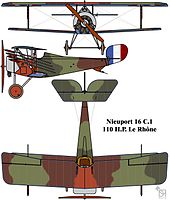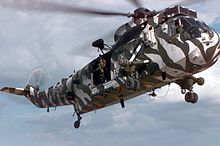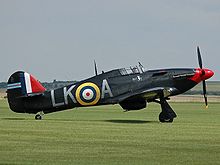Aircraft camouflage

Aircraft camouflage is the use of
Aircraft were first camouflaged during World War I; aircraft camouflage has been widely employed since then. In World War II, disruptive camouflage became widespread for fighters and bombers, sometimes combined with countershading. Some air forces such as the German Luftwaffe varied their paint schemes to suit differing flight conditions such as the skyglow over German cities, or the sands of the Mediterranean front.
During and after World War II, the
History
World War I

The French were

In mid-1916, the Germans experimented with a transparent cellulose acetate covering on several aircraft, including a Fokker E.III, that rendered the aircraft nearly invisible from most angles, however the sun reflecting off it defeated it even before its lack of durability did.[4] When the Germans fielded the Albatros D.III biplane, pilots readily confused them with similarly shaped Nieuports which used the same combination of colours. The solution the Germans came up with was to replace the red-brown with purple, which from a distance still worked well as a camouflage colour, but could readily identify the aircraft as German. As in France, individual manufacturers applied a variety of camouflage finishes, dependent on their own interpretations of what was required. Light grey (LFG Roland C.II), patches of greens and browns (Fokker D.II) and streaky olive green finish over a turquoise base (Fokker Dr.I) were all used until April 1917, when pre-printed lozenge camouflage (Lozenge-Tarnung) was introduced with up to 5 colours.[5][6]
Aircraft of the British
World War II
During the
Some United States Army Air Forces aircraft used a variation of the British camouflage schemes (mostly on aircraft originally built to RAF orders) but most USAAF aircraft did not use multiple shades on the top side of the aircraft. Instead, most were camouflaged in olive drab above and neutral gray below, though some had the edges of flying surfaces painted in medium green.[13] In the later stages of the war, camouflage was often dispensed with, both to save time in manufacturing and to reduce weight, leaving aircraft with a natural metal finish.[14]
Soviet Air Forces aircraft were painted with shades of green, either plain or in disruptive patterns above, and blue-grey on the undersurfaces.[15][16]

The basic German (Luftwaffe) camouflage during most of the war was based on a light blue undersurface and a two tone splinter pattern of various greens for the upper surfaces. In the first year of the war, the top colours were dark green and black-green; later, lighter and more greyish colours were used for fighters, though bombers mostly maintained the dark green/black green camouflage. The side of the fuselage on fighters and some light bombers often had irregular patches sprayed on, softening the transition from the upper to the lower surface. The undersides of night bombers and night fighters were painted black early in the war, but by 1943 switched to lighter base colours of their usual light blue undersurfaces for aircraft flown by day, and a light gray base coat over the upper surfaces to match the skyglow over the German cities they were tasked with defending.[17] A special pattern was devised for the Mediterranean front, consisting of a sand yellow that often faded to tan, with or without olive green patches. As Germany lost air supremacy, ground camouflage became increasingly important, and late war fighters received a two tone scheme like the British Sand and Spinach, in dark brown and light green.[18]
Cold War and after
During the
In the 1970s, heat-seeking missiles were developed that had a range greater than the visual acuity of pilots. Aircraft camouflage now had two major threats that it was not able to fully defeat—radar and infrared detection. Camouflage accordingly became less important.[25] However, by the 1980s, the human eye was again seen as sufficiently important a threat that aircraft like the ground attack A-10 Thunderbolt (Warthog) were painted in camouflage schemes that included both disruptive ground coloration and automimicry (deceptive self-imitation), in the form of a false canopy on the underside.[26][27]
Methods
Camouflage for aircraft is complicated by the fact that the aircraft's background varies widely, depending on the location of the observer, the nature of the background[28] and the aircraft's motion. For this reason, military aircraft were often painted to match the sky when viewed from below, and to either match the ground or break up the aircraft's outline when viewed from above. This is a form of countershading, likely to work best on aircraft such as heavy bombers that do not fly inverted during combat.[26] Because of the way light hits it, patterns of dark and light will often be present on an aircraft even if it is entirely one colour, making it easier to see[29] Reflections and specular highlights can be counteracted by painting an aircraft in neutral shades with a non-reflective, matte finish.[29] There is a trade-off between the effectiveness of camouflage and the size of recognition markings: larger markings reduce the risk of friendly fire through misrecognition, but compromise camouflage.[30]
Ground camouflage

Ground camouflage is used to delay visual acquisition from the air of an aircraft that is on or near the ground. Light sand has been used for aircraft used over
Air camouflage
Camouflage for an airborne aircraft may attempt to provide concealment with colours resembling the background. For example, until 1941, Royal Air Force fighters were painted in ground colours (dark green and brown) above, and sky colours below. However, aircraft were being lost, and pilots reported that the colours used made their fighters conspicuously darker than the sky. The

Night camouflage
Military aircraft flying at night have often been painted black or other dark colours, applied to just the underside of some aircraft and to the entirety of others, in the hope of reducing the risk of being seen in enemy searchlights or by night fighters.[39] However, aircraft camouflaged with black paint are actually darker than the night sky, making them more visible to observers not using searchlights.[25] The undersides of Heinkel He 111 night bombers were painted black.[40] The De Havilland Mosquito was similarly initially painted black when used as a night fighter; matte black was found to be the best at reducing the aircraft's visibility against searchlights, but the aircraft's speed was reduced by 15 mph (24 km/h) compared to glossy black, which, being smoother, produced less drag. Since, however, black camouflage made the planes conspicuous on moonlit nights and against cloud, a variation of a day camouflage scheme was eventually chosen.[41]
Active camouflage

In the early years of World War II, German
During the
Stealth technology
Stealth technology aims to make aircraft almost undetectable by radar or other sensors, whether infrared, visible, or acoustic. This is effectively multi-spectral camouflage.[44] Work began on stealth technology in America in 1958.[45][46]
The

Preventing contrails
Camouflage may extend beyond an aircraft's airframe. High-flying aircraft can sometimes be detected by their vapor contrails. Researchers have considered whether these might be reduced with the use of chemical additives.[51] Work was carried out on a contrail management system for B-2 stealth bombers in 1994.[52][53] From the Second World War onwards, reconnaissance pilots took care to avoid creating contrails, varying their altitude as necessary; the Lockheed U-2 reconnaissance aircraft was equipped with a mirror to enable the pilot to see if the plane was creating a contrail, and to take action accordingly.[54]
Digital camouflage
Digital camouflage patterns, widely used for uniforms with designs such as
See also
Notes
- ^ A Jaguar in a winter scheme can be seen at File:Sepecat Jaguar GR1A, UK - Air Force AN1985498.jpg.
- ^ The weight saved and any consequent improvement in speed or range depends on the aircraft type. Defense Media Network calculated that a Boeing B-17 Flying Fortress carried some 300 pounds of paint, on the basis of a painted area of 4200 square feet. That needed some 35 gallons of lead-based paint weighing some 10 pounds per gallon, giving a wet weight of 350 pounds and a dry weight of perhaps 300 pounds after evaporation. The article noted that contemporary reports were more conservative, estimating 15–20 pounds for a fighter, 70–80 pounds for a bomber. Planes with polished surfaces tested by both RAF and Proving Ground Command flew up to 8 mph (13 km/h) faster.[38]
- ^ In a crosswind, pilots had to fly with sideslip to keep the aircraft nose and Yehudi lights pointed towards the target.[42]
References
- ^ Toelle, Alan. "Nieuport Camouflage of 1916, Parts 1 and 2", color artwork by Ronny Bar., Windsock Worldwide, Volume 23, Issues Nos. 5 and 6. Berkhamsted UK: Albatros Productions, 2007.
- ^ Hardesty, Bergen F.; Hastings, H. D.; Toelle, Alan D. (1968). "Project Butterfly". Cross & Cockade (US). 9 (1).
- ^ Hardesty, Bergen F.; Hastings, H. D.; Toelle, Alan D. (1972). "Project Butterfly". Cross & Cockade (US). 13 (2).
- ^ Guttman, 2014 pp.34-35
- ^ "German Lozenge Camouflage". Archived from the original on 15 June 2017. Retrieved 7 April 2015.
- ^ Newark 2007, pp. 68–69.
- ISBN 978-0948414657.
- ISBN 0-7603-1051-3.
- ^ "Camouflage during the First World War". Imperial War Museum. Retrieved 5 June 2020.
- ISBN 1-85532-597-7.
- ISBN 978-1-4738-5104-7.
Bomber Command was of the opinion that the application of the current Temperate Land Scheme of Dark Green and Dark Earth to the upper surfaces was a waste of time and labour.
- ^ Air Publication 2656A in "Development of Squadron Markings and Codes 1939–1945" Air of Authority. 26 May 2017
- ISBN 1-84176-061-7.
- ^ a b Newark 2007, p. 144.
- ISBN 978-0-973-99940-2.
- ISBN 978-1-903-22330-7.
- ^ Price, Alfred (1967). Aircraft in Profile No.148 – The Junkers Ju 88 Night Fighters. Leatherhead: Profile Publications. p. 16.
- ISBN 3-7637-6201-9
- Flight: 741. 11 November 1955.
- ISBN 978-1-8441-5815-7.
- ISBN 978-0-16-075367-1.
- ISBN 978-1-78200-749-4.
- ISBN 978-1-84908-756-8.
- ISBN 978-1-4728-0179-1.
- ^ a b c d e Douglass, Steve; Sweetman, Bill (May 1997). "Hiding in Plane Sight: Stealth aircraft own the night. Now they want the day". Popular Science. pp. 54–59.
- ^ a b Shaw 1985, p. 382.
- ISBN 0-89747-400-7.
- ^ Shaw 1985, p. 380.
- ^ a b Shaw 1985, p. 381.
- ^ "FM 3-01.80 (FM 44-80) Visual Aircraft Recognition" (PDF). Department of the Army. 2006. pp. 2–5. Retrieved 6 February 2017.
However, ground observers must deal with camouflage patterns because the patterns break up aircraft outlines, making aircraft more difficult to recognize and identify.
- ISBN 0-618-12742-9.
- ^ a b Shaw 1985, p. 383.
- ^ Humphreys, Adolph H.; Jarvis, Sharon V. (1 February 1974). "Camouflage Pattern Painting Report of Usamerdc's Camouflage Support Team to Masster" (PDF). DTIC. Archived from the original (PDF) on June 8, 2016. Retrieved 18 March 2017.
- ^ Dougherty 2017, p. 149.
- ISBN 978-1-78274-277-7.
- ISBN 978-1-58007-124-6.
- ISBN 978-0-8317-5058-9.
- ^ Zimmerman, Dwight John (23 February 2014). "The U.S. Army Air Forces Strips Its Planes of Paint". Defense Media Network.
- ^ Stephenson, Hubert Kirk. (1948) Applied Physics, pp. 200, 258. Science in World War II; Office of Scientific Research and Development. Volume 6 of Science in World War II (Atlantic Monthly Press Book). Editors: Chauncey Guy Suits and George Russell Harrison. Little, Brown.
- ISBN 978-0-7864-5280-4.
- ^ Birtles, Philip (2017). De Havilland Mosquito: The Original Multirole Combat Aircraft. Fonthill Media. p. 209. GGKEY:XL1896UPHXD.
- ^ a b Bush, Vannevar; Conant, James; et al. (1946). "Camouflage of Sea-Search Aircraft" (PDF). Visibility Studies and Some Applications in the Field of Camouflage. Office of Scientific Research and Development, National Defence Research Committee. pp. 225–240. Archived from the original (PDF) on October 23, 2013. Retrieved February 12, 2013.
- ^ Shaw 1985, p. 55.
- ^ Rao, J. V. Ramana (1999). "Introduction To Camouflage And Deception". New Delhi: Defence Research & Development Organisation. p. 4.
The conventional methods of camouflage and deception are no longer adequate in the present-day advanced technology warfare scenario. The field has acquired new dimensions under the names such as stealth technology, low observable technology, very low observable technology, or signature management. In this context, the conventional methods of camouflage, concealment and deception serve only the preliminary stages. The concept of multispectral/ polyspectral camouflage under the name stealth technology has to embody countermeasures to detection by radar, infrared, visible and acoustic sensors and any other sensor that may be employed.
- ^ Richelson, J.T. (10 September 2001). "Science, Technology and the CIA". The National Security Archive. The George Washington University. Retrieved 8 March 2017.
- ^ Merlin, P.W. (2009). Design and Development of the Blackbird: Challenges and Lessons Learned. American Institute of Aeronautics and Astronautics. Archived from the original on 2013-05-11. Retrieved 2017-09-08.
{{cite book}}:|work=ignored (help) - ^ "Lockheed F-117A Nighthawk". National Museum of the United States Air Force. Retrieved 8 March 2017.
- Air & Space (December 2007/January 2008). Archived from the originalon 2012-07-19.
- ISBN 0-316-74330-5.
- ^ Kopp, Carlo (1989). "Optical Warfare – The New Frontier". Australian Aviation. 1989 (November 1989/January 1990). Air Power Australia. Retrieved 8 March 2017.
- ^ "How to disappear". The Economist. No. Technology Quarterly Q3 2008. 4 September 2008. Retrieved 29 March 2017.
- ^ Axe, David (13 December 2012). "7 Secret Ways America's Stealth Armada Stays Off the Radar". Wired. Retrieved 29 March 2017.
- ^ Vartabedian, Ralph (2 February 1994). "Trail at End of B-2 Leads to Northrop Contract : Aircraft: Air Force will pay $63.5 million to get rid of the wispy white contrails that give away stealth bomber's location". Los Angeles Times. Retrieved 29 March 2017.
- ISBN 978-0-7643-2346-1.
- )
- ^ "Mig-29 in HyperStealth Digital Thunder Disruption Camouflage". HyperStealth. 21 March 2008.
- ^ "'Digital Thunder' Camo for Slovakia's MiG-29s". Defense Industry Daily. 25 March 2008.
- ^ "PAK FA and Su-35S: The Future of the Russian Air Force". Defense-Aerospace.com. Retrieved 16 June 2017.
Sources
- Dougherty, Martin J. (2017). Camouflage At War: An Illustrated Guide from 1914 to the Present Day. Amber Books. ISBN 978-1-78274-498-6.
- Newark, Tim (2007). Camouflage. Thames and Hudson, with ISBN 978-0-500-51347-7.
- Shaw, Robert (1985). Fighter combat: tactics and maneuvering. Naval Institute Press. ISBN 0-87021-059-9.
Further reading
- Robertson, Bruce (1966). Aircraft camouflage and markings, 1907–1954 (Sixth ed.). Aero Publishing. ISBN 0-8168-6355-5.
External links
- A series of experimental camouflage patterns Archived 2018-09-19 at the Wayback Machine tried on the General Dynamics F-111 Aardvark
- 2009 Aggressor Blue camouflage on an F/A-18E Super Hornet
- German Lozenge Aircraft Camouflage Archived 2017-06-15 at the Wayback Machine

